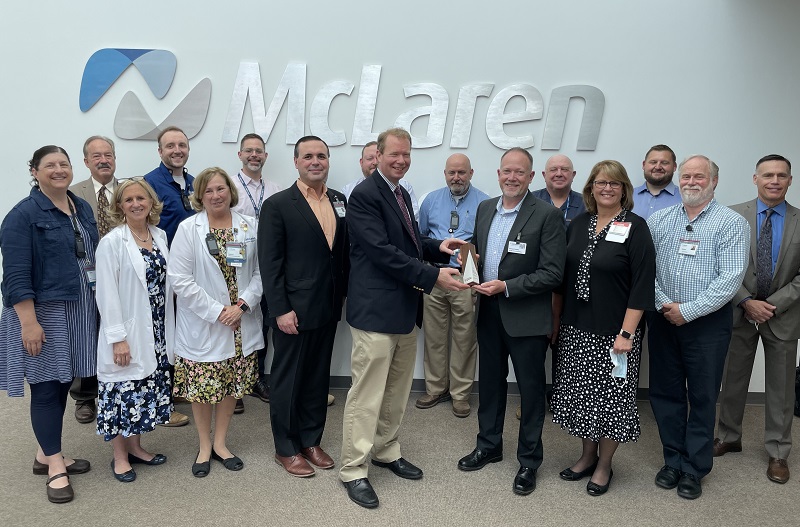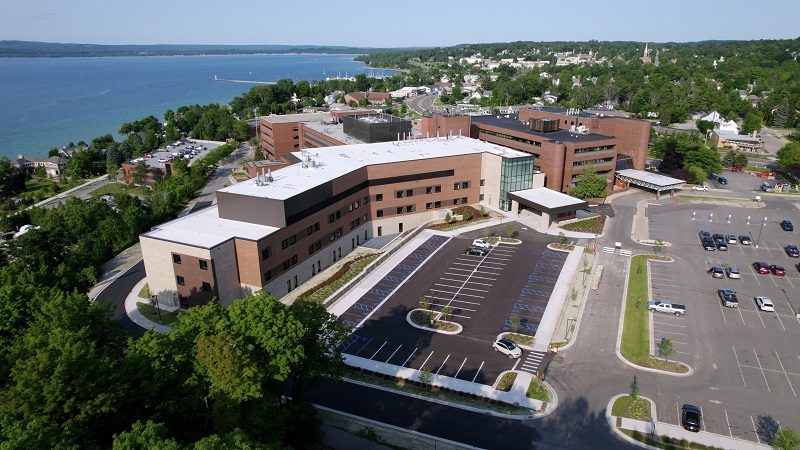Congratulations!
McLaren Northern Michigan (Petoskey, Michigan) has been selected as the winner of ECRI's 16th Health Technology Excellence Award for its successful integration of a wide array of patient care technologies for a newly constructed addition to the hospital. By requiring multiple technology vendors to work together, McLaren was able to implement a solution that optimizes the flow of information to and from clinicians, and that provides patients with easy access to the resources they need to understand their care and to be comfortable during their stay.
The Health Technology Excellence Award recognizes outstanding initiatives undertaken by member healthcare institutions to improve patient safety, reduce costs, or otherwise facilitate better strategic management of health technology. ECRI announced McLaren Northern Michigan as the winner of the 16th award in May 2022.
ECRI congratulates the McLaren team, particularly Rich Reamer, Jennifer Woods, Shari Schult, Todd Burch, and Bob Turk.
 Jason Launders, ECRI's Director of Operations, Device Evaluation, presents the award to Rich Reamer and members of the McLaren team. 
|
The Challenge
To improve patient care and enhance the patient experience by building an integrated patient care technology environment within a newly constructed addition to McLaren Northern Michigan hospital. McLaren's approach to achieving these goals involved first bringing together the suppliers of the technologies that would be used in the space, and then challenging them to work together to build an integrated solution that streamlined the delivery of information to the care team.
The Context
McLaren Northern Michigan is a 202-bed regional hospital located in Petoskey, Michigan. The facility serves residents in 22 counties across northern Lower Michigan and the eastern part of the Upper Peninsula. Years ago, McLaren began planning a new addition to the site. The new space would house:
- Three floors of private patient rooms (ICU, cardiovascular unit, and med surg)
- A range of clinical care areas, including OR suites, postanesthesia care (PACU) holding areas, and cardiac catheterization and electrophysiology labs
- Services such as pharmacy and sterile processing
When designing the addition, the organization knew it wanted more than just new physical spaces; it wanted to build the safest and most advanced integrated patient experience. That meant putting considerable thought into which technologies would be used in those spaces, how those technologies would interact with one another, and what implementation measures would be required to ensure that the technologies functioned well together.
Leadership, clinical engineering, and IT worked in lockstep toward this goal. After years of project planning and construction implementation, as well as numerous visits to vendors to track progress, the new pavilion opened its doors to patients in August 2021.
 McLaren Northern Michigan hospital. (Image courtesy of McLaren Northern Michigan.)
McLaren Northern Michigan hospital. (Image courtesy of McLaren Northern Michigan.) |
The Process
One of the most consequential parts of this project was "The Meeting." McLaren brought together—in one room, at one time—the sales and technical teams from an array of equipment and services vendors. The participants represented companies that provide high-quality solutions within specific areas of expertise, namely nurse call, patient monitoring, staff communications, electronic medical record (EMR), real-time locating system (RTLS), patient safety, virtual nursing, patient education, Internet Protocol television (IPTV), and patient interaction and entertainment.
During that meeting, McLaren nursing leadership and clinical engineering management presented the following challenge: What would it look like if all of you worked together to build the best integrated solution? What additional benefits might be realized if we, collectively, work to integrate each of your products so that information is delivered to our care teams through a single interface?
"You could hear a pin drop." That's how Rich Reamer, McLaren Regional Manager of Clinical Engineering, described the initial atmosphere at that meeting. Participants were protective of their products, and didn't necessarily want to mix their products in with the others. "But once everybody opened up their mind to what we were doing, the walls started coming down," Reamer explained. It didn't take long for the initial discomfort to give way to excitement and energy. Ultimately, vendors saw potential in being able to tout their successful integration with other technologies.
For McLaren, success required selecting product solutions that use an open architecture, and identifying vendor partners who were willing to collaborate. The system is now operational, but Rich Reamer wouldn't describe it as having crossed the finish line. "With this kind of project, you'll always be incorporating new systems or adjusting things to make improvements based on how you see the tools being used once they are in the clinicians' hands."
 McLaren Northern Michigan's new pavilion interconnects many different technologies to enhance staff communication and workflow, improve safety, educate patients on their care, and provide a comfortable stay. (Image courtesy of McLaren Northern Michigan.)
McLaren Northern Michigan's new pavilion interconnects many different technologies to enhance staff communication and workflow, improve safety, educate patients on their care, and provide a comfortable stay. (Image courtesy of McLaren Northern Michigan.) |
The Results
One of McLaren's key requirements for its technology-integration initiative was to optimize the flow of information to and from clinicians—providing them with data they need to care for patients, but doing so in a way that is not overwhelming. The organization's extensive planning yielded a system that integrates the following technologies and data sources:
- Staff communication device (Vocera). McLaren selected a hands-free communication device to be the primary connection between clinicians and the other integrated technologies. The system supports team communications with simple voice commands, and it delivers data from the other systems without interrupting patient-caregiver interactions. McLaren implemented the communications system before the new facility opened and before the other technologies were brought online. This was done so that users could gain comfort with the communication devices before they would need to use them to interact with so many other new systems.
- Nurse call system (Rauland R5). The nurse call system informs clinicians of patient requests and emergent needs.
- Physiologic monitoring and telemetry (Spacelabs). These devices send critical data about the patient's physiologic condition.
- Bed (Stryker iBed Awareness). This system provides information about the patient's bed settings, and it issues alerts regarding potential falls.
- EMR (Cerner). Data from many of the other systems regarding the proper management of the patient is recorded in, and accessible through, the EMR.
- Electronic whiteboard (Medi+Sign). This system, which incorporates a digital whiteboard in the patient's room, displays automated and real-time updates related to the patient's care. It displays the plan of care and schedule for the day, pain level, care team assignments, test results, bed settings, and a myriad of other data points. It also communicates bed-exit alerts in real time from the Stryker wireless iBed.
- Virtual nurse (Banyan). A TV-mounted camera and audio system in the patient room allow a "virtual nurse" (i.e., a nurse connecting from a remote location) to assist with questions and concerns, and even assist during alert events by providing an extra set of eyes and ears, as well as audible support.
- RTLS (Midmark). The system helps users quickly locate staff and devices, which can be critical during safety events. The system also can be set up to support call escalations by directing the call to the closest staff member who has the needed skill. McLaren indicates that it is not yet using the full capabilities of the RTLS component; it first needs to upgrade the infrastructure in its preexisting spaces so that the technology can be used throughout the facility, rather than in just the new pavilion.
A second key requirement was to provide patients with easy access to the resources they need to understand their care and to be comfortable during their stay. The following components are instrumental in that regard:
- Bedside patient tablet (Curbell Rego). This tablet replaces the traditional nurse call pendant/remote control. Patients can use the device to call for nurse assistance or to control the television and room lights. They also can use it to access their medical record through their private portal within the McLaren Health Care system, to communicate with the virtual nurse, or to access the internet, stream videos, or use social media.
- IPTV (Telehealth IPTV). In addition to providing cable TV and other patient entertainment, this system can be used to connect with the virtual nurse; to view test results, radiology images, or documentation of treatment and other requested information; or to display patient-specific education regarding the patient's stay and their condition.
McLaren notes that, when taken all together, the integrated system offers:
- Six automated integrated systems working in concert to monitor, alert staff to, and mitigate the risk of patient injury or falls
- Four automated systems to educate patients on their specific needs
- Three patient-interactive systems to support their experience and comfort
- Four integrated systems that support staff safety, infection prevention, and reporting of critical results
- Nine total systems working together—either in total integration or in a supporting capacity—to improve safety and quality outcomes for the hospital's patients
Key Takeaways
Following are a few of the lessons learned and key points reported by the McLaren team:
- The initial meeting with vendors was a critical first step. "It took that initial conversation to open up the thought process," observed Rich Reamer. Attitudes changed from "We haven't done it that way before" to "We probably can do that; team, let's find a way."
- A specific project management professional should be assigned to oversee projects of this scale.
- IT and clinical engineering are critical drivers of a successful implementation. Keep each team engaged and informed of changes and needs as the project progresses.
- End users will require a lot of training; keeping them informed about the benefits they will experience with the new system can help with engagement.
- Infrastructure changes will likely be needed, so be sure to budget for them. Also, plan for continued IT and CE involvement throughout the life of the systems (for things like server maintenance, system configuration changes, and floor plan map corrections).